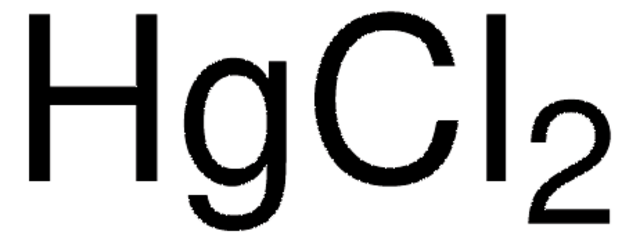655198
Cadmium chloride
technical grade
Sinónimos:
Cadmium dichloride, Dichlorocadmium
About This Item
Productos recomendados
grado
technical grade
Nivel de calidad
densidad de vapor
6.3 (vs air)
presión de vapor
10 mmHg ( 656 °C)
Formulario
solid
concentración
≥55.2% Cd (EDTA titration)
mp
568 °C (lit.)
solubilidad
H2O: soluble >457 g/L at 20 °C (OECD Test Guideline 105)
cadena SMILES
Cl[Cd]Cl
InChI
1S/Cd.2ClH/h;2*1H/q+2;;/p-2
Clave InChI
YKYOUMDCQGMQQO-UHFFFAOYSA-L
¿Está buscando productos similares? Visita Guía de comparación de productos
Categorías relacionadas
Aplicación
Palabra de señalización
Danger
Frases de peligro
Consejos de prudencia
Clasificaciones de peligro
Acute Tox. 2 Inhalation - Acute Tox. 3 Oral - Aquatic Acute 1 - Aquatic Chronic 1 - Carc. 1B - Muta. 1B - Repr. 1B - STOT RE 1
Código de clase de almacenamiento
6.1A - Combustible acute toxic Cat. 1 and 2 / very toxic hazardous materials
Clase de riesgo para el agua (WGK)
WGK 3
Equipo de protección personal
Eyeshields, Faceshields, Gloves, type P3 (EN 143) respirator cartridges
Listados normativos
Los listados normativos se proporcionan para los productos químicos principalmente. Para los productos no químicos sólo se puede proporcionar información limitada. Si no hay ninguna entrada, significa que ninguno de los componentes está en la lista. Es obligación del usuario garantizar el uso seguro y legal del producto.
EU REACH SVHC Candidate List
EU REACH Annex XVII (Restriction List)
Elija entre una de las versiones más recientes:
¿Ya tiene este producto?
Encuentre la documentación para los productos que ha comprado recientemente en la Biblioteca de documentos.
Los clientes también vieron
Nuestro equipo de científicos tiene experiencia en todas las áreas de investigación: Ciencias de la vida, Ciencia de los materiales, Síntesis química, Cromatografía, Analítica y muchas otras.
Póngase en contacto con el Servicio técnico











